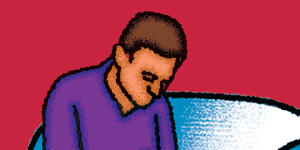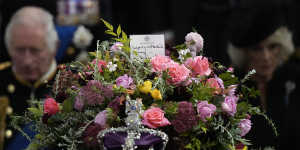
Illustration:Jim Pavlidis.
Perhaps all kids did this (do they still?),but I wonder if part of the reason I loved that book so much was the depth of my hatred for handwriting. We spent so much time,at school,learning how to write neatly,learning block-letters and then,my hatred growing,running-writing. I was awful at handwriting,it never looked good,and this made me feel terrible. When I started high school an optometrist suggested asking the school for permission to write with crayons,which may have been a good suggestion but made me feel worse still.
Last week,I watched what will certainly be the most elaborate ritual I see in my life – the Queen’s funeral. Despite the pomp,or because of it,I was most struck by its similarity to other funerals,the same two things at its centre:the person who had lived and the reminder of the solid fact of death. Mourners and ceremony were spread across the country,but my mind kept returning to the one small person at their centre,a woman,dead now,who had once worn that small purple crown that lay atop the box that now contained her.
Next to that crown were flowers,and nestled among them was a plain white card,on which King Charles had written,“In loving and devoted memory – Charles R”. During the service,a spider ran across the top of the white card. Both the handwriting and the spider seemed out of place,incongruously unregimented:two protesting signs of life in a formal ceremony marking death.
Something of these blurrings – between life and death,between personality and impersonality – was captured with typical brilliance in a short description several years ago by the novelist Hilary Mantel. Upon,Mantel stared;the Queen turned,“as if she had been jabbed in the shoulder”,and met Mantel’s eye with a look of “hurt bewilderment”. For a moment,the Queen “had turned back from a figurehead into the young woman she was,before monarchy froze her and made her a thing”. This is what death does too,of course:makes each of us a thing.

The crown,flowers and handwritten note from King Charles on the Queen’s coffin.AP
I wish I could read Mantel on the events of these past weeks,but I can’t because she also died,just a few days ago. There was nobody who wrote better on royalty,in part because there was nobody who wrote better about power and its limitations,which was also why she captured so precisely,in her portrait of Thomas Cromwell,what it was like to be a political staffer,with its odd cross of obsequiousness and influence.
Somewhere at home I have a card that bears her handwriting. I once entered a short story competition that she judged. Afterwards I wrote to thank her,and – unnecessarily,though apparently not unusually – she sent me back a Christmas card. I had to squint to read several of the words.
So perhaps good handwriting is overrated. Or perhaps handwriting,whether good or bad,is like royalty,and like life,and perhaps like everything in life:a battle is always being fought between the structures that are handed down and our desire to assert ourselves against them. We are told how the letters must be formed,and then we try to form them that way ourselves. Something in us always presses against this discipline,though,and in the end,the battle over,something of ourselves has become visible in the odd shapes of the letters that we leave on the page.
Perhaps it seems strange that I identify handwriting with life,given how much I once hated it and how little I do it now. But it makes sense to me because there is something of death in what I think of as handwriting’s opposite,the endless text on our computers,in those fonts I once so loved. Death imposes sameness. And computers,too,impose sameness,particularly on the internet,and even more so on social media,where,as somebody I forget remarked,everybody is desperately trying to prove their individuality in exactly the same way. Technology,too,turns us into things.
Perhaps mass mourning has made me more alert to death in general,but it seems a lot of artists have died these past weeks. Two of my favourite novelists – Mantel,and Javier Marias,who I – died at 70. The hugely influential film director,,died. In Australia,we lost the actors and. At the beginning of the month,the writer Barbara Ehrenreich died. Artists lie at the opposite end of the spectrum from the Queen:when we read their work,or watch their plays or films,we do so with the wish to see a person,entire and inimitable.
We applaud the way they discard tired structures and impose themselves instead. We have spent some weeks now admiring impersonal duty. Its opposite is just as important and just as admirable.
Sean Kelly is author ofThe Game:A Portrait of Scott Morrison,a regular columnist and a former adviser to Julia Gillard and Kevin Rudd.
The Opinion newsletter is a weekly wrap of views that will challenge,champion and inform your own..